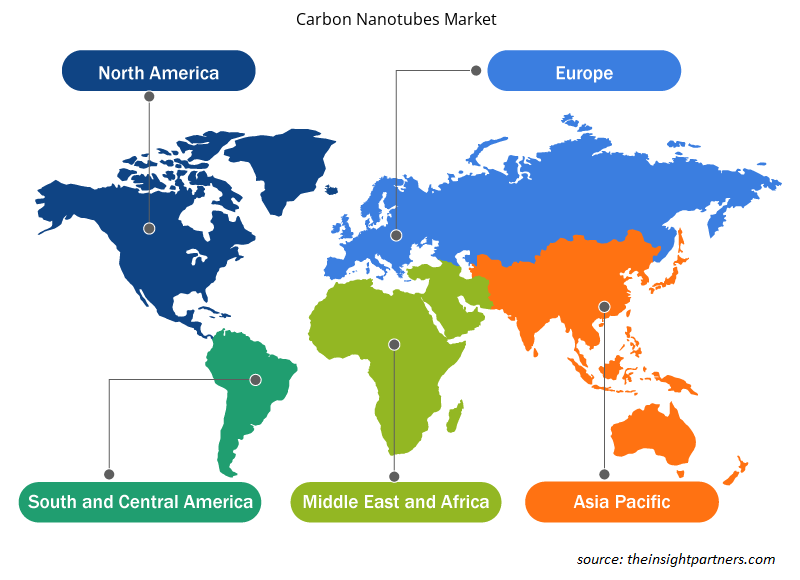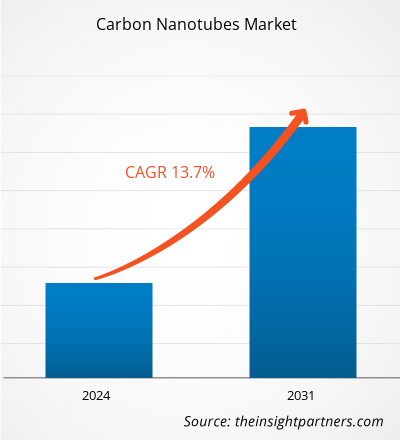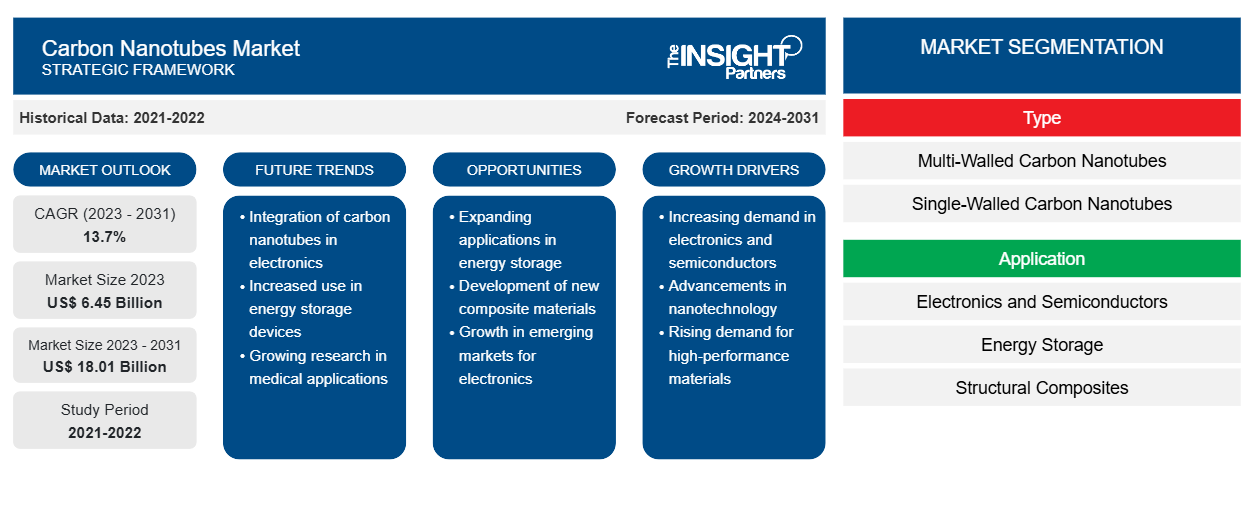Si prevede che la dimensione del mercato dei nanotubi di carbonio raggiungerà i 18,01 miliardi di dollari entro il 2031, rispetto ai 6,45 miliardi di dollari del 2023. Si prevede che il mercato registrerà un CAGR del 13,7% nel periodo 2023-2031. L'incorporazione di CNT nell'inchiostro nanocomposito per la stampa 3D può migliorare la funzionalità del processo di stampa avanzato e conferire proprietà dissipative elettrostatiche.
Analisi del mercato dei nanotubi di carbonio
La crescente domanda di sostituti leggeri del metallo con caratteristiche termiche, elettrochimiche e meccaniche superiori ha portato a una fiorente ricerca rivolta alla ricerca di compositi e materiali compositi. I progressi tecnologici e le applicazioni microscopiche di nuova generazione nel settore elettrico ed elettronico necessitano di materiali efficienti e altamente funzionali come i CNT. Inoltre, la tecnologia dei compositi basati su CNT è ampiamente utilizzata nei settori aerospaziale, della difesa, automobilistico e delle infrastrutture. La National Aeronautics and Space Administration (NASA) ha finanziato uno Space Technology Research Institute (STRI) quinquennale denominato US-COMP, avviato nel 2017, per la ricerca e lo sviluppo di compositi basati su CNT. La ricerca è focalizzata sull'innovazione di materiali leggeri ad altissima resistenza per l'applicazione nei veicoli di esplorazione. Inoltre, nel 2020, Toray Industries Inc ha sviluppato un processo di comunicazione wireless con un identificatore di radiofrequenza stampato utilizzando compositi basati su CNT semiconduttivi, parzialmente supportato dal Ministero dell'ambiente giapponese. Il semiconduttore composito CNT dell'azienda offre una mobilità di 182 cm2/Vs, rispetto ai circuiti integrati e ai semiconduttori stampati a basso costo, che offrono una mobilità di 20 cm2/Vs.
Panoramica del mercato dei nanotubi di carbonio
I nanotubi di carbonio sono strutture cilindriche estremamente piccole fatte di atomi di carbonio. Sono noti per le loro proprietà uniche, tra cui elevata resistenza alla trazione, stabilità termica e buona conduttività elettrica. I nanotubi di carbonio a parete singola e i nanotubi di carbonio a parete multipla sono due tipi di nanotubi di carbonio. I nanotubi di carbonio a parete singola sono fatti di un singolo strato di atomi di carbonio arrotolati in un tubo, mentre i nanotubi di carbonio a parete multipla sono costituiti da diversi tubi concentrici. I nanotubi di carbonio sono usati come materiali di rinforzo nei materiali compositi, materiali di rilevamento nei sensori, accumulo di energia nelle batterie, catalizzatori nelle reazioni chimiche e per applicazioni biomediche. Nel settore medico, sono usati per la somministrazione di farmaci, biosensori, imaging e ingegneria tissutale. Nel settore elettronico , i nanotubi di carbonio sono impiegati come transistor, interconnessioni, sensori, display, accumulo di energia, ecc.
Personalizza questo report in base alle tue esigenze
Riceverai la personalizzazione gratuita di qualsiasi report, comprese parti di questo report, o analisi a livello nazionale, pacchetto dati Excel, oltre a usufruire di grandi offerte e sconti per start-up e università
-
Scopri le principali tendenze di mercato in questo rapporto.Questo campione GRATUITO includerà analisi di dati che spaziano dalle tendenze di mercato alle stime e alle previsioni.
Driver e opportunità del mercato dei nanotubi di carbonioNanotubes Market Drivers and Opportunities
Crescente domanda di nanotubi di carbonio (CNT) per applicazioni di accumulo di energiaNanotubes (CNTs) for Energy Storage Applications
I nanotubi di carbonio sono nanostrutture di carbonio con proprietà elettrochimiche e meccaniche caratteristiche come elevata resistenza e rigidità, bassa densità, elevata conduttività termica e conduttività elettrica. Le proprietà dei CNT vengono sfruttate per la ricerca e lo sviluppo di sistemi di accumulo di energia. I CNT a parete singola e multiparete vengono utilizzati come additivi conduttivi nelle batterie agli ioni di litio e per sviluppare elettrodi per batterie per migliorare le prestazioni delle batterie. La crescente domanda di sistemi energetici, insieme al suo costo crescente, ha spinto le organizzazioni governative e i ricercatori a sviluppare sistemi energetici efficienti per soddisfare gli obiettivi energetici globali.nanotubes are carbon nanostructures with characteristic electrochemical and mechanical properties such as high strength and rigidity, low density, high heat conductivity, and electrical conductivity. The properties of CNTs are leveraged for the research and development of energy storage systems. Single-walled and multi-walled CNTs are utilized as conductive additives in Li-ion batteries and to develop battery electrodes to enhance battery performance. The rising demand for energy systems, along with its increasing cost, has influenced government organizations and researchers to develop efficient energy systems to fulfill global energy targets.
Adozione dei nanotubi di carbonio per la cura del cancroNanotubes for Cancer Treatment
I recenti progressi nella somministrazione di farmaci e nel trattamento del cancro comportano l'utilizzo di nanocarrier come CNT, nanocapsule lipidiche solide, nanoparticelle magnetiche, nanoparticelle d'oro e liposomi. Le proprietà elettriche, ottiche, chimiche e meccaniche dei CNT sono impiegate nei sistemi di somministrazione di farmaci, nell'imaging biomedico e nella tecnologia antimicrobica. Pertanto, la tecnologia di somministrazione di farmaci antitumorali basata su CNT sta guadagnando popolarità, soprattutto grazie al suo targeting selettivo e al controllo della somministrazione del farmaco. Gli scienziati hanno sviluppato una nuova tecnologia per introdurre direttamente il farmaco antitumorale, la doxorubicina, attraverso i CNT da sacche sferiche di molecole fosfolipidiche (liposomi) tramite la membrana plasmatica cellulare. Un rapporto pubblicato dal Dipartimento dell'Energia degli Stati Uniti nel 2022 ha rivelato che i CNT fondono liposomi e cellule tumorali, avviando la fusione delle membrane liposomiali e delle cellule tumorali. Questo processo di fusione consente al farmaco di passare liberamente dal liposoma alla cellula. Ciò si traduce nell'efficace somministrazione di doxorubicina, eliminando fino al 90% delle cellule disordinate. Pertanto, l'adozione di CNT nel trattamento del cancro può creare opportunità redditizie per il mercato dei nanotubi di carbonio durante il periodo di previsione.nanocarriers such as CNTs, solid lipid nanocapsules, magnetic nanoparticles, gold nanoparticles, and liposomes. The electrical, optical, chemical, and mechanical properties of CNTs are employed in drug delivery systems, biomedical imaging, and antimicrobial technology. Therefore, CNT-based anticancer drug delivery technology is gaining popularity, especially due to its selective targeting and controlling of drug delivery. Scientists have developed a novel technology to directly introduce the anticancer drug—doxorubicin—through CNTs from spherical sacs of phospholipid molecules (liposomes) via the cell plasma membrane. A report published by the US Department of Energy in 2022 revealed that CNTs merge liposomes and cancer cells, initiating the merger of liposomal membranes and cancer cells. This fusion process allows the drug to pass freely from the liposome to the cell. This results in the effective delivery of doxorubicin, eliminating up to 90% of disordered cells. Thus, the adoption of CNTs in cancer treatment can create lucrative opportunities for the carbon nanotubes market during the forecast period.
Analisi della segmentazione del rapporto di mercato sui nanotubi di carbonio
I segmenti chiave che hanno contribuito alla derivazione dell'analisi di mercato dei nanotubi di carbonio sono tipologia e applicazione.
- In base al tipo, il mercato dei nanotubi di carbonio è suddiviso in nanotubi di carbonio multiparete e nanotubi di carbonio monoparete. Il segmento dei nanotubi di carbonio multiparete ha detenuto una quota di mercato maggiore nel 2023.
- Per applicazione, il mercato è segmentato in elettronica e semiconduttori, accumulo di energia, compositi strutturali, aerospaziale e difesa, medicale e altri. Il segmento dei compositi strutturali ha detenuto la quota maggiore del mercato nel 2023.
Analisi della quota di mercato dei nanotubi di carbonio per area geografica
L'ambito geografico del rapporto sul mercato dei nanotubi di carbonio è suddiviso principalmente in cinque regioni: Nord America, Asia Pacifico, Europa, Medio Oriente e Africa e Sud America/Sud e Centro America.
L'Asia Pacifica ha dominato il mercato dei nanotubi di carbonio. Il mercato dell'Asia Pacifica è suddiviso in Australia, Cina, India, Giappone, Corea del Sud e resto dell'Asia Pacifica. L'Asia Pacifica è emersa come un mercato importante per i nanotubi di carbonio a causa della crescente domanda di materiali ad alte prestazioni in vari settori come aerospaziale, automobilistico, elettronico ed energetico. La regione è diventata un importante hub per la produzione di nanotubi di carbonio, con diversi produttori leader che operano in paesi come Cina, Giappone e Corea del Sud. Inoltre, la Cina è uno dei più grandi mercati per i nanotubi di carbonio nell'Asia Pacifica e il paese segnala investimenti significativi in ricerca e sviluppo e una crescente adozione di nanotubi di carbonio in varie applicazioni. Diverse aziende cinesi come Shenzhen Nanotech Port Co. Ltd., Chengdu Organic Chemicals Co. Ltd. e Suzhou NanoGrid Technology Co. Ltd. sono coinvolte nella produzione e commercializzazione di nanotubi di carbonio.
Approfondimenti regionali sul mercato dei nanotubi di carbonio
Le tendenze regionali e i fattori che influenzano il mercato dei nanotubi di carbonio durante il periodo di previsione sono stati ampiamente spiegati dagli analisti di Insight Partners. Questa sezione discute anche i segmenti e la geografia del mercato dei nanotubi di carbonio in Nord America, Europa, Asia Pacifico, Medio Oriente e Africa e America meridionale e centrale.

- Ottieni i dati specifici regionali per il mercato dei nanotubi di carbonio
Ambito del rapporto sul mercato dei nanotubi di carbonio
| Attributo del report | Dettagli |
|---|---|
| Dimensioni del mercato nel 2023 | 6,45 miliardi di dollari USA |
| Dimensioni del mercato entro il 2031 | 18,01 miliardi di dollari USA |
| CAGR globale (2023-2031) | 13,7% |
| Dati storici | 2021-2022 |
| Periodo di previsione | 2024-2031 |
| Segmenti coperti |
Per tipo
|
| Regioni e Paesi coperti |
America del Nord
|
| Leader di mercato e profili aziendali chiave |
|
Attori del mercato dei nanotubi di carbonio Densità: comprendere il suo impatto sulle dinamiche aziendali
Il mercato dei nanotubi di carbonio sta crescendo rapidamente, spinto dalla crescente domanda degli utenti finali dovuta a fattori quali l'evoluzione delle preferenze dei consumatori, i progressi tecnologici e una maggiore consapevolezza dei benefici del prodotto. Con l'aumento della domanda, le aziende stanno ampliando le loro offerte, innovando per soddisfare le esigenze dei consumatori e capitalizzando sulle tendenze emergenti, il che alimenta ulteriormente la crescita del mercato.
La densità degli operatori di mercato si riferisce alla distribuzione di aziende o società che operano in un particolare mercato o settore. Indica quanti concorrenti (operatori di mercato) sono presenti in un dato spazio di mercato in relazione alle sue dimensioni o al valore di mercato totale.
Le principali aziende che operano nel mercato dei nanotubi di carbonio sono:
- Nanoshel LLC
- NanoLab Inc
- Kumho Petrochemical Co Ltd
- Klean Industries Inc
- LG Chem Ltd
Disclaimer : le aziende elencate sopra non sono classificate secondo un ordine particolare.

- Ottieni una panoramica dei principali attori del mercato dei nanotubi di carbonio
Notizie e sviluppi recenti sul mercato dei nanotubi di carbonio
Il mercato dei nanotubi di carbonio viene valutato raccogliendo dati qualitativi e quantitativi post-ricerca primaria e secondaria, che includono importanti pubblicazioni aziendali, dati di associazioni e database. Di seguito è riportato un elenco degli sviluppi nel mercato dei disturbi del linguaggio e della parola:
- A settembre 2020, Arkema ha stretto una partnership con la Korea Association of Carbon-Nano Industry. La partnership con l'associazione aiuterà Arkema a migliorare la propria offerta di prodotti.
- Nell'agosto 2020, ChemSpec North America ha annunciato un accordo di distribuzione non esclusivo con Nanocyl SA, con sede in Belgio, per promuovere e distribuire i vari prodotti a nanotubi di carbonio multiparete ("MWCNT") di Nanocyl negli Stati Uniti e in Canada.
- Nell'agosto 2022, LG Chem ha annunciato l'espansione del suo investimento nei nanotubi di carbonio (CNT) con la costruzione del più grande impianto di produzione di CNT a linea singola al mondo.
- A marzo 2023, Canatu Oy (Vantaa, Finlandia), uno sviluppatore di nanomateriali al carbonio, ha annunciato un aggiornamento nella sua produzione di film di nanotubi di carbonio (CNT) per soddisfare la crescente domanda di prodotti per riscaldatori ADAS nel settore automobilistico. Canatu ha dichiarato di aver migliorato la sua linea di produzione di film CNT step-and-repeat (SAR) aggiungendo una nuova capacità di reattore e aumentando il livello di automazione.
- Nell'aprile 2020, OCSiAl ha annunciato di poter commercializzare fino a 100 tonnellate all'anno dei suoi nanotubi di carbonio a parete singola TUBALL in Europa, grazie al dossier aggiornato dell'azienda ai sensi della normativa UE "Registrazione, valutazione, autorizzazione e restrizione delle sostanze chimiche" (REACH), risultando inoltre conforme ai nuovi allegati sulle forme nano.
Copertura e risultati del rapporto sul mercato dei nanotubi di carbonio
Il rapporto “Dimensioni e previsioni del mercato dei nanotubi di carbonio (2021-2031)” fornisce un’analisi dettagliata del mercato che copre le seguenti aree:
- Dimensioni e previsioni del mercato a livello globale, regionale e nazionale per tutti i segmenti di mercato chiave coperti dall'ambito
- Dinamiche di mercato come fattori trainanti, vincoli e opportunità chiave
- Principali tendenze future
- Analisi dettagliata delle cinque forze PEST/Porter e SWOT
- Analisi di mercato globale e regionale che copre le principali tendenze di mercato, i principali attori, le normative e gli sviluppi recenti del mercato
- Analisi del panorama industriale e della concorrenza che copre la concentrazione del mercato, l'analisi della mappa di calore, i principali attori e gli sviluppi recenti
- Profili aziendali dettagliati
- Analisi storica (2 anni), anno base, previsione (7 anni) con CAGR
- Analisi PEST e SWOT
- Valore/volume delle dimensioni del mercato - Globale, Regionale, Nazionale
- Industria e panorama competitivo
- Set di dati Excel
Report recenti
Testimonianze
Motivo dell'acquisto
- Processo decisionale informato
- Comprensione delle dinamiche di mercato
- Analisi competitiva
- Analisi dei clienti
- Previsioni di mercato
- Mitigazione del rischio
- Pianificazione strategica
- Giustificazione degli investimenti
- Identificazione dei mercati emergenti
- Miglioramento delle strategie di marketing
- Aumento dell'efficienza operativa
- Allineamento alle tendenze normative























 Ottieni un campione gratuito per - Mercato dei nanotubi di carbonio
Ottieni un campione gratuito per - Mercato dei nanotubi di carbonio